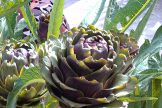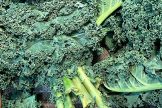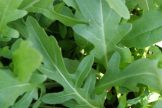
 Important note about plant availability. Important note about plant availability.There are hundreds of factsheets on our website provided for your information. Not all plants will be available at all times throughout the year. To confirm availability please call (03) 8850 3030 and ask for the nursery. |
Colocasia esculenta
A perennial, tropical plant primarily with large arrow or heart shaped leaves. Primarily grown as a root vegetable for its edible starchy corm, but also as a leaf vegetable. Taro cannot be use raw.
The corms can be roasted, baked, fried, steamed or boiled, used in stews and soups, and the natural sugars give a sweet nutty flavour. The starch is easily digestible and grains are fine and small and often used for baby food. The leaves are a good source of vitamins A and C and contain more protein than the corms.
Growing Taro
Plant taro as soon as the frosts have finished in spring and the soil has warmed. They require a minimum of 200 frost free days to mature, so get them in as soon as you can. Space 40cm – 60cm apart in rows at least 1m apart.
Taro corms can be planted in dry or wet settings. In Asia taro is often planted in wet paddys. In dry setting, taro corms are planted in furrows or trenches about 6 inches (15cm) deep and covered by 2 to 3 inches (5-8cm) of soil. Keep very moist and feed with a lot of compost and a rich organic high potassium fertiliser.
Tubers are harvested around 200 days after planting when leaves turn yellow and start to die. Lift the roots before the first autumn frosts. Leaves can be picked as soon as they open, but never strip the plant of all its leaves, just pick a few at a time.





